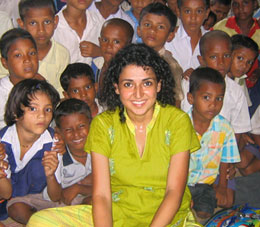 Afsoon Donna Houshidari during her UNICEF internship in India in the summer of 2006
Afsoon Donna Houshidari during her UNICEF internship in India in the summer of 2006"It dawns on me several times in one day during moments like this one - sitting in Lucknow, India, researching international legislation on labour rights on a computer that through some miracle made it through the street of rioters leading to the university, while listening to a French band via my Argentinean colleague's ipod, and writing home to friends in Toronto - how intertwined the world has become. And then I read Stiglitz's Globalisation and Its Discontents and my comfortable surroundings are put into perspective by what I saw a week ago in villages - people permanently without electricity and access to adequate drinking water (!) who are ostensibly living in the same country where 24-hour American style shopping malls are springing up like weeds and I.T. outsourcing from North America is booming. How is it that such change has happened so rapidly in some parts of the country-and the world-while other areas remain so deprived?"
I wrote the above while participating in UNICEF's Knowledge Community for Children in India (KCCI) internship for graduate students from around the world. Having completed my second year of law school at the University of Toronto, I set off to spend nearly three months in New Delhi, Lucknow, Varanasi, and several rural villages as one of three students assigned to UNICEF's Bal Adhikar (Child Rights) Initiative. Established in 2000 in partnership with IKEA, the Swedish international home furnishings retailer, the Initiative aims to prevent and eliminate child labour in India's carpet industry. IKEA sources the majority of their carpets from a region in Uttar Pradesh that has come to be known as India's "carpet belt"; this region is responsible for almost 85 percent of India's carpet exports.
Whether in the realm of industry, culture, spirituality, economics, or politics, this subcontinent possesses a rich history and fascinating future. Little wonder then at my excitement to discover the plethora of activities and issues that abound there, and to contribute to the work of UNICEF addressing the rights of children. The law - its power and its limitations - became evident to me as I set out in India's second poorest state, just as the monsoon rains began to pour.
Together with a PhD student from MIT and another law student from India itself, we analysed the Bal Adhikar Initiative to discover what effects the project is having on the local community, what its best practices are, its lessons learned, and what potential areas of improvement we can identify. Needless to say, researchers more qualified in the carpet industry and child labour than myself are researching the project and the broader issues of child rights and corporate social responsibility; however, the value we add as interns was to look at the project with a set of objective, independent and "fresh eyes" and to contribute to the growth of a base of knowledge regarding the situation of children in India. Personally, the process of learning and investigating first hand such a project brought together my two central interests prior to law school: education and justice. Both can serve as a powerful form of social transformation towards greater equality. The project solidified my theoretical understandings of this relationship, but also added new dimensions to consider, such as the role of corporate social responsibility and of international interventions.
From the children weaving carpets under thatched roofs in rural villages, to IKEA's corporate social responsibility representative in New Delhi, I spoke with all stakeholders in the project. I interviewed teachers, surveyed parents, shadowed NGO field workers, learned from university professors, interacted with members of the government's Planning and Labour Departments, and consulted with UNICEF project managers. As a team, we broke down the machinery of the project and immersed ourselves in the cultural and political reality of the villages and the nation. I researched international and national child labour legislation, and learned of their limitations. We spent a month at our home base at the University of Lucknow learning about the history of the project, and then we traveled for two weeks throughout villages where it was being carried out. After returning to the University of Lucknow, we spend another month collating our data and writing a report for UNICEF that is currently in the editing process in hopes that it will be published and sent to all relevant government and NGO heads.
To further my understanding of the complex issue that is child labour, and to make a greater contribution to it, I have used the internship as a springboard for a research project this semester at the Faculty, with the encouragement of Dean Moran and under the supervision of Professor Carol Rogerson. In my view, internships such as this one, that serve to consolidate old interests and pique new ones, motivate research, facilitate the formation of important networks, enhance a wide range of skills, and stimulate personal growth, should be a staple of any university education.

